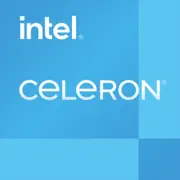Intel Celeron N5100

Intel Celeron N5100: A Budget Processor for Basic Tasks — A Detailed Review for 2025
(Current as of April 2025)
Architecture and Manufacturing Process: 10 nm, Four Cores, and Modest Ambitions
The Intel Celeron N5100, released in 2021, remains popular in budget laptops thanks to its energy-efficient Jasper Lake architecture.
Design Features
- Cores and Threads: 4 cores (Tremont) and 4 threads. This is an evolution of the Atom architecture optimized for low power consumption.
- Clock Speeds: Base clock is 1.1 GHz, with a maximum turbo frequency of 2.8 GHz. However, under stable loads, it rarely exceeds 2.3–2.5 GHz due to TDP limitations.
- Integrated Graphics: Intel UHD Graphics (24 EU, up to 850 MHz). Supports 4K H.265/VP9 video decoding but is not designed for gaming.
- Cache and Memory: 4 MB L3 cache, supports DDR4/LPDDR4x (up to 2933 MHz).
Practical Note: The Tremont architecture focuses on improving IPC (instructions per cycle) by 30% compared to Gemini Lake but lags behind "bigger" Core processors in complex tasks.
Power Consumption and TDP: 10 W for Passive Cooling
A TDP of 10 W allows the Celeron N5100 to be used in thin fanless laptops, reducing noise and device cost.
- Thermal Output: Even under peak load, the temperature rarely exceeds 70°C.
- Power Saving Scenarios: Technologies like Intel Speed Shift (fast frequency switching) and Dynamic Tuning (load adaptation) extend battery life.
Example: The Acer Aspire 1 (N5100) runs for up to 10 hours when web-surfing thanks to passive cooling and optimization.
Performance: What Can the Celeron N5100 Handle?
Office Tasks
- Microsoft Office, Google Docs: No problems. Simultaneous work with 10+ browser tabs + a Word document is possible, though there may be stuttering during switching.
- Zoom/Teams: HD video calls are stable, but background noise cancellation and effects can load the CPU to 70-80%.
Multimedia
- 4K Video: Smooth playback through VLC or YouTube (hardware decoding).
- Photo Editors: Lightroom Mobile or basic GIMP functions are acceptable, but photo exports will take 2-3 times longer than on a Core i3.
Gaming
- Light Titles: Minecraft (30–40 FPS on low settings), Dota 2 (720p, 25–30 FPS), Among Us — playable.
- Turbo Mode: A brief "boost" up to 2.8 GHz helps with short tasks (OS loading, opening apps) but is nearly unnoticeable in gaming.
Important: For gaming, it’s better to connect an external GPU via Thunderbolt (if available), but laptops with N5100 are scarce.
Use Cases: Who is This Processor For?
- Students: For lectures, working with texts, and online courses.
- Office Workers: Managing emails, spreadsheets, CRM systems.
- Home Users: Watching Netflix, social media, video calls.
- Travelers: Compact laptops with long battery life (e.g., Chuwi Minibook X).
Not Suitable For: Video editors, streamers, gamers, engineers (CAD).
Battery Life: How Long Will It Last?
- Typical Runtime: 8–12 hours in mixed mode (50% brightness, Wi-Fi on).
- Power Saving Technologies:
- C-States: Disabling unused cores.
- Display Power Saving: Automatic reduction of GPU frequency when the image is static.
Tip: Choose models with a battery of at least 40 Wh (e.g., Lenovo IdeaPad 1 15″ — 45 Wh).
Comparison with Competitors: Who's Stronger in 2025?
- AMD Athlon Silver 3050e (Zen): 2 cores/4 threads, 6 W TDP. Underwhelming in multi-threaded tasks (Geekbench 6 Multi: ~900) but cheaper. Example: HP 14s-fq0000 — $270.
- Intel Pentium Silver N6000 (Jasper Lake): 4 cores/4 threads, higher GPU frequency (850 MHz). Better for gaming but more expensive ($350+).
- Apple M1 (in re-released MacBook Air 2023): 4 times higher performance but priced from $799.
Conclusion: The Celeron N5100 is a compromise for those who want a budget option under $400.
Pros and Cons: What to Consider Before Buying?
Strengths
- Laptop prices: $300–450.
- Quiet operation (passive cooling).
- Support for modern codecs (4K HDR).
Weaknesses
- Low performance in "heavy" applications.
- No support for PCIe 4.0, Thunderbolt 4.
- Limited upgradeability: often non-removable RAM and only 1 SSD slot.
Laptop Selection Recommendations
1. Device Type: Ultrabooks (Asus ExpertBook B1), Chromebooks (Acer Chromebook 315), 2-in-1 hybrids (Lenovo Flex 3).
2. Minimum Requirements:
- Screen: IPS panel (not TN!), resolution 1920×1080.
- Storage: 256 GB SSD (avoid eMMC).
- Ports: USB-C with charging support, HDMI.
3. Popular Models in 2025:
- Dell Inspiron 15 3520: 15.6″ FHD, 8 GB RAM, 256 GB SSD — $349.
- HP 15s-eq2000: Touchscreen, 12 hours of battery life — $379.
Final Verdict: Is It Worth It?
Intel Celeron N5100 is a choice for those who:
- Seek a laptop under $400 for basic tasks.
- Value quiet operation and long battery life.
- Don’t plan to run "heavy" programs.
Key Benefits: Low price, energy efficiency, support for modern video. However, if the budget allows for an additional $100–150, consider laptops with Intel Core i3-1215U or AMD Ryzen 3 7320U — they will last longer and perform better in multitasking.
Basic
CPU Specifications
Memory Specifications
GPU Specifications
Miscellaneous
Benchmarks
Compared to Other CPU
Share in social media
Or Link To Us
<a href="https://cputronic.com/en/cpu/intel-celeron-n5100" target="_blank">Intel Celeron N5100</a>